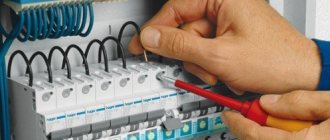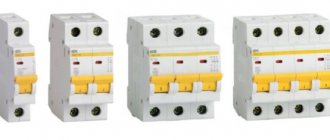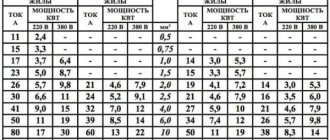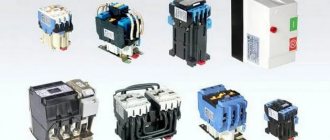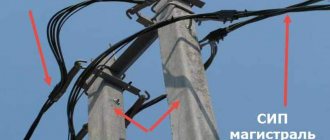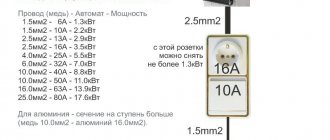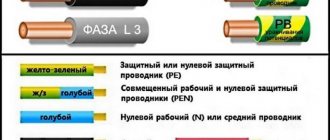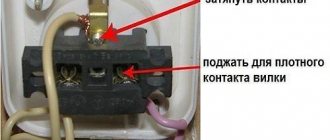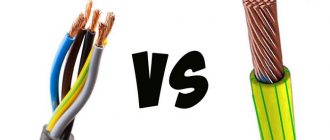Selecting a machine based on cable cross-section and load power
For quite some time now, modern homes have stopped using corks. They were replaced by more technological devices - automatic machines, also known as baggers, although some still call them traffic jams, but this is wrong, because the operating principle of a traffic jam and a machine is somewhat different. Since in this article we will consider the selection of a machine depending on the cable cross-section, there will be no talk about traffic jams.
So, the machine is a device that allows you to open the electrical circuit automatically in two cases:
- line current overload;
- occurrence of a short circuit (SC).
In the first case, overload occurs due to a malfunction of electrical appliances or their large number and power density. In the second case, due to a short circuit, electricity is consumed to heat the wires with the maximum possible current for this section. In addition to the above cases of circuit breakage, the machine provides the possibility of manual control. There is a switch on the body of the device that allows you to open the circuit.
The purpose of the circuit breaker is to protect the section of the electrical circuit for which it is installed, as well as timely opening of this section in the event of an overload or short circuit.
Possible correction of the core cross-section for line resistance
Any conductor has its own resistance - we talked about this at the very beginning of the article, when we cited the resistivity values of materials, copper and aluminum.
Both of these metals have very decent conductivity, and in short sections the line’s own resistance does not have any significant effect on the overall parameters of the circuit. But if you plan to lay a long line, or, for example, a long-length carrying extension cord is being manufactured to work at a considerable distance from the house, then it is advisable to calculate your own resistance and compare the voltage drop it causes with the supply voltage. If the voltage drop is more than 5% of the nominal voltage in the circuit, the operating rules for electrical installations require the use of a cable with conductors of a larger cross-section.
For example, a carrying case for a welding inverter is made. If the resistance of the cable itself is excessive, the wires will overheat greatly under load, and the voltage may not be enough for the device to operate correctly.
The cable's own resistance can be calculated using the formula:
Rk = 2 × ρ × L/S
Rk—own resistance of the cable (line), Ohm;
2 - the cable length doubles, since the entire current path is taken into account, that is, “there and back”;
ρ is the resistivity of the cable core material;
L—cable length, m;
S is the cross-sectional area of the core, mm².
It is assumed that we already know what current we will have to deal with when connecting the load - this has already been discussed more than once in this article.
Knowing the current strength, it is easy to calculate the voltage drop using Ohm's law and then compare it with the nominal value.
Ur = Rk × I
ΔU (%) = (Ur / Unom) × 100
If the test result is more than 5%, then the cross-section of the cable cores should be increased by one step.
Another online calculator will help you quickly carry out such a check. It seems that he will not require additional explanations.
Long distance line voltage drop test calculator
As already mentioned, with a value of up to 5% you can not change anything. If it turns out more, the cross-section of the cable core is increased, also with subsequent checking.
* * * * * * *
So, the main issues regarding the required cable cross-section depending on the planned load on it were considered. The reader is free to choose any of the proposed calculation methods, whichever he likes best.
Let's end the article with a video on the same topic.
How to calculate the power of a machine
In order to provide the most effective and accurate overload protection, the formula is used to calculate the machine’s power for a 220V network:
in which the rated current is expressed by I, the sum of the powers of all powered consumers including lighting devices is P, and the voltage of the electrical network is U. Thus, the value of the rated current will increase with an increase in the total power of consumers.
And for a 380V network, the power calculation of the machine is made according to the formula:
in which the cosφ value is added, meaning the power factor (the exact value can be found in Table 6.12 of the SP 31-110-2003 standard “Design and installation of electrical installations in residential and public buildings”). To simplify calculations in everyday conditions, cosine phi is taken equal to one. In general, this coefficient depends on the type of electrical receiver, for example:
- for lighting networks with fluorescent lamps, the power factor is 0.92;
- for lighting networks with incandescent lamps - one;
- for gas-light advertising installations - from 0.35 to 0.4;
- for computers without technological air conditioning - 0.65;
- for refrigerators and air conditioners with an electric motor up to 1 kW, cosφ is equal to 0.65, and with a motor of 1 - 4 kW, the power factor increases to 0.75.
Let's try to calculate the machine's power using an example. Let's say you are trying to protect a group of three kitchen outlets from short circuits. In one, a refrigerator with a power of 400 W is constantly turned on, in others, a microwave or kettle (1000 W) or a blender (300 W) is periodically connected. Let's calculate the total power if you want to simultaneously connect the most powerful devices: 400 + 1000 + 1000 = 2400 W. The current strength for a 220V network is as follows:
And we recommend choosing a machine based on power in favor of the closest 10A rating. A natural concern may arise: will it “knock out” when applying more voltage to such a nominal value? In fact, if you apply a load of 15 amps to a 10-amp protective device, the operation will occur in eight minutes, and if you apply 11 amps, then it will take as long as twenty minutes. During this time, the kettle will turn off and the load will again become acceptable - much earlier than the release switches on.
How to choose a circuit breaker in the case of a three-phase input, which is relevant for private houses and some new buildings? You can either use the power factor formula or refer to the table.
Parallel connection of electrical wiring wires
There are hopeless situations when you urgently need to lay wiring, but there is no wire of the required cross-section available. In this case, if there is a wire with a smaller cross-section than necessary, then the wiring can be made from two or more wires, connecting them in parallel. The main thing is that the sum of the sections of each of them is not less than the calculated one.
For example, there are three wires with a cross section of 2, 3 and 5 mm2, but according to calculations, 10 mm2 is needed. Connect them all in parallel and the wiring will handle up to 50 amps. Yes, you yourself have repeatedly seen the parallel connection of a large number of thin conductors to transmit large currents. For example, welding uses a current of up to 150 A and in order for the welder to control the electrode, a flexible wire is needed. It is made from hundreds of thin copper wires connected in parallel. In a car, the battery is also connected to the on-board network using the same flexible stranded wire, since when starting the engine, the starter consumes current from the battery up to 100 A. And when installing and removing the battery, the wires must be taken to the side, that is, the wire must be flexible enough .
The method of increasing the cross-section of an electrical wire by connecting several wires of different diameters in parallel can be used only as a last resort. When laying home electrical wiring, it is permissible to connect in parallel only wires of the same cross-section taken from the same reel.
Cables GOST 31996–2012
When choosing a machine, it is necessary to take into account the characteristics of the cables. The most important is the permissible current (Iperm). It shows at what maximum current the cable can operate throughout its entire service life. This table from the PUE contains information about permissible cable currents depending on the material and conditions of cable laying.
Permissible currents for cable depending on materials
| Open wiring | Cable cross-section, mm2 | Closed wiring | ||||||||||
| Copper | Aluminum | Copper | Aluminum | |||||||||
| Current A | Power, kWt | Current A | Power, kWt | Current A | Power, kWt | Current A | Power, kWt | |||||
| 220 V | 380 V | 220 V | 380 V | 220 V | 380 V | 220 V | 380 V | |||||
| 11 | 2.4 | — | — | — | — | 0.5 | — | — | — | — | — | — |
| 15 | 3.3 | — | — | — | — | 0.75 | — | — | — | — | — | — |
| 17 | 3.7 | 6.4 | — | — | — | 1 | 14 | 3 | 5.3 | — | — | — |
| 23 | 5 | 8.7 | — | — | — | 1.5 | 15 | 3.3 | 5.7 | — | — | — |
| 26 | 5.7 | 9.8 | 21 | 4.6 | 7.9 | 2 | 19 | 4.1 | 7.2 | 14 | 3 | 5.3 |
| 30 | 6.6 | 11 | 24 | 5.2 | 9.1 | 2.5 | 21 | 4.6 | 7.9 | 16 | 3.5 | 6 |
| 41 | 9 | 15 | 32 | 7 | 12 | 4 | 27 | 5.9 | 10 | 21 | 4.6 | 7.9 |
| 50 | 11 | 19 | 39 | 8.5 | 14 | 6 | 34 | 7.4 | 12 | 26 | 5.7 | 9.8 |
| 80 | 17 | 30 | 60 | 13 | 22 | 10 | 50 | 11 | 19 | 38 | 8.3 | 14 |
| 100 | 22 | 38 | 75 | 16 | 28 | 16 | 80 | 17 | 30 | 55 | 12 | 20 |
| 140 | 30 | 53 | 105 | 23 | 39 | 25 | 100 | 22 | 38 | 65 | 14 | 24 |
| 170 | 37 | 64 | 130 | 28 | 49 | 35 | 130 | 29 | 51 | 75 | 16 | 28 |
From this table you can find the required cable cross-section and permissible current depending on the wiring conditions, open or buried. For example, the power of all appliances in the apartment is 9 kW. For open single-phase copper wiring, the wire cross-section is 4 mm 2, current 41A, for closed - the nearest higher power value is 11 kW, cross-section 10 mm 2, current 50A. The nearest lower rating of the circuit breaker is 32A.
If there is doubt about the quality of the electrical wiring, then it is better to exercise caution and choose a machine with a rating lower than the value in the table.
The residential network has a branched structure: a current of different strength will flow in each branch, so the wires have different cross-sections. If you install one circuit breaker only at the entrance, it will not be able to protect individual sections of the wiring from overload. If the entire network is laid with a cable of the same cross-section, then this is an unjustified financial expense. The best solution would be to install the appropriate current on each section of the machine. The figure shows an approximate structure.
Installation of machines for the appropriate current
The figure clearly shows the load on each section and the cross-section of the wire. By installing appropriate circuit breakers, you can reliably protect the entire network from short circuits or overloads. In addition, at any time it is possible to select and disable one or another section, maintaining the functionality of the rest of the network.
When using powerful asynchronous motors in everyday life, especially 3-phase ones, for example, power tools, it is advisable to turn them on through a separate circuit breaker, since they have a large starting current, and when operating through a common circuit breaker, a power outage may occur even during normal operation of the equipment.
Circuit breaker current
Automatic currents come from the following series:
0,5, 1, 1,6, 2, 3,15, 4, 5, 6, 8, 10, 13, 16, 20, 25, 32, 40, 50, 63.
The denominations most often used in everyday life are highlighted in bold. There are other denominations, but we won’t talk about them now.
This current for the circuit breaker is rated. If it is exceeded, the switch will turn off. True, not immediately, as stated below:
What determines the choice of cable cross-section?
The main task of preserving the original functionality of an electrical cable is to prevent it from overheating. This can be solved very simply if 1 mm2 is subjected to a load in the form of a long-term total current not exceeding 9 Amperes. When translating this indicator into a more familiar value for the average person - power, it turns out that a conventional cable with a cross-section of 1 mm2 can be used to power electrical appliances with a power consumption of up to 2 kW. If such numerical transformations cause difficulties, and a special online calculator
is not available at the right time, you just need to remember a few simple rules.
- Cable for lighting – core cross-section 1.5 mm2.
- Cable for all sockets, air conditioning, loggias - core cross-section 2.5 mm2.
- Cable for electric ovens – core cross-section 4 mm2.
- Cable for hobs and instantaneous electric water heaters – core cross-section 6 mm2.
Important! The cable supplying outlets and lighting systems may break, have branches and connections. And all others from the list presented above must be solid. This means that to organize power supply for, say, an oven, a special line of cable with a cross-section of 4 mm2 must be laid directly from the panel, and with the installation of a separate machine. This is a standard and there is no situation that would allow us to deviate from it and organize branches to power other power devices. Any joint on such a line is a minus to durability and reliability.
Voltage
230/400V - inscriptions of the rated voltage where this machine can be used.
If there is a 230V icon (without 400V), these devices should only be used in single-phase networks. You cannot put two or three single-phase switches in a row and thus supply 380V to a motor load or a three-phase pump or fan.
Also carefully study bipolar models. If they have the letter “N” written on one of the poles (not only automatic machines), then this is where the neutral conductor is connected, and not the phase conductor.
They are called slightly differently. For example VA63 1P+N.
The wave icon means - for operation in alternating voltage networks.
It is better not to install such devices for constant voltage and current. The characteristics of its shutdown and the result of operation during a short circuit will not be predictable.
Switches for direct current and voltage, in addition to the straight line icon, may have characteristic inscriptions “+” (plus) and “-” (minus) on their terminals.
Moreover, the correct connection of the poles is critical here. This is due to the fact that the conditions for extinguishing the arc at direct current are somewhat more difficult.
If during alternating periods the arc is naturally extinguished when the sinusoid passes through zero, then during constant periods there is no sinusoid as such. To sustainably extinguish the arc, they use a magnet installed near the arc extinguishing chamber.
Which will lead to inevitable destruction of the body.
Application of measuring instruments
To determine the diameter of the cores of wires and cables, various measuring instruments are widely used, showing the most accurate results. Basically, the use of micrometers and calipers is practiced for these purposes. Despite their high efficiency, a significant drawback of these devices is their high cost, which is of great importance if the tool is planned to be used only 1-2 times.
As a rule, professional electricians who are constantly engaged in electrical installation work use special devices. With the right approach, it becomes possible to measure the diameter of wire cores even on working lines. After obtaining the necessary data, all that remains is to use a special formula:
The result of the calculation will be the area of the circle, which is the cross-section of the wire or cable core.
Calculation for premises
The previous calculation made it possible to accurately calculate the material and cross-section of the input cable through which the total maximum load will flow. Now you should make similar calculations for each room and its groups. And here's why: the load on socket groups can vary significantly.
Thus, sockets with a connected washing machine and hair dryer are loaded much more than the socket for a mixer and coffee maker in the kitchen. Therefore, you should not “simplify” the task by laying a wire with a cross-section of 2.5 square meters on the sockets without hesitation, since sometimes this is simply not enough.
It should be remembered that usually the kitchen and bathroom are the most “loaded” lines, since this is where the refrigerator, electric kettle, boiler, microwave, and sometimes washing machine are located. Therefore, it is best to distribute this load among different outlet groups, rather than using a block of 5-6 outlets.
Sometimes you can hear from “experts” that for sockets in other rooms a “one and a half cable” is enough, but would you highlight those black stripes visible from under the wallpaper that a burnt cable leaves behind after turning on an oil heater or fan heater? !
The most common brands of wires and cables:
- PPV - flat copper two- or three-core with single insulation for laying hidden or fixed open wiring;
- APPV - aluminum flat two- or three-core with single insulation for laying hidden or fixed open wiring;
- PVA - round copper, number of cores - up to five, with double insulation for laying open and hidden wiring;
- SHVVP – round copper with twisted conductors, double insulation, flexible, for connecting household appliances to power sources;
- VVG - round copper cable, up to four cores with double insulation for laying in the ground;
- GDP - round single-core copper cable with double PVC (polyvinyl chloride) insulation, P - flat (current-carrying conductors are located in the same plane).
Which machine to choose for 2.5 mm2 cable?
For consumers whose total power will not exceed 3.5 kW, we recommend using a copper cable with a cross-section of 2.5 sq. mm and protecting these lines with a 16A automatic.
For a copper cable with a cross-section of 2.5 sq. mm according to Table 1.3.6 of the PUE, the long-term permissible current is 27A. Based on this, you might think that a 25A machine will fit such a cable. But that's not true. By the way, for those who don’t know where to look, I publish this table:
According to the PUE, clause 1.3.10, a current value of 25A will heat up a 2.5 sq. mm cable to 65 degrees Celsius. This is a high enough temperature for constant operating modes.
It is also important to understand that not all manufacturers produce cables in accordance with GOST and its cross-section may be lower than declared. So the cross section could be 2.0 sq.mm instead of 2.5 sq.mm. The quality of copper also differs between factories and you cannot be guaranteed to accurately say what quality of cable you have.
Therefore, a reserve in cable protection is very important to avoid problems during the operation of electrical wiring. The choice of machine according to the cable cross-section is carried out as follows:
- I use a 1.5 sq. mm cable when installing alarms and lighting; it corresponds to a 10A machine;
- a 2.5 sq. mm cable is often used for individual sockets and socket groups, where the total power of consumers will not exceed 3.5 kW. It corresponds to the current ratings of 16A automatic machines;
- a 4 sq. mm cable is used in everyday life to connect ovens, washing machines and dishwashers, heaters and water heaters; they buy a 25A automatic machine for it;
- a 6 sq. mm cable is needed to connect serious powerful consumers: electric stoves, electric heating boilers. Machine rating 32A;
- a cable of 10 sq. mm is usually the maximum cross-section used in everyday life, intended for supplying power to apartments and private houses to electrical panels. Automatic 40A.
To calculate the electrical network at home, boldly and strictly follow the table and guide provided above. With the correct calculation of power lines and protective devices, everything will work for a long time and will not bring you any inconvenience or problems.
Weak link protection
In addition to the cross-section, when choosing suitable cable products, pay attention to the actual operating conditions. Standardized values are given for heating to a temperature not exceeding +60°C
When installing the line on a site near a country house, it is necessary to provide protection from humidity and other adverse external influences.
Carefully check all parts of the electrical network. The basic rule is reliable protection, taking into account the performance of the area with the worst parameters. It should be taken into account that copper is designed with the same cross-section for greater loads compared to aluminum. The purity of the metal is of certain importance. As impurities increase, conductivity deteriorates and losses due to useless and dangerous heating increase.
Indoor wiring device
- the introductory machine must be placed before the counter;
- a general residual current device (RCD) is installed behind the control device;
- Next, separate lines are equipped with automatic switches (AB).
The RCD prevents accidents that provoke leakage currents. In some situations, it prevents electric shock. However, complex protective measures are carried out using circuit breakers. Effective grounding must be used.
As a rule, it is convenient to install several groups in the kitchen to evenly distribute the loads. It is recommended to carefully select the distribution of powerful consumers:
- hobs;
- ovens;
- heating boilers, boilers, flow heaters;
- electric convectors, heat guns;
- air conditioners.
The wiring diagram has a tree structure. They make the necessary “branches” for connecting sockets and switches.
